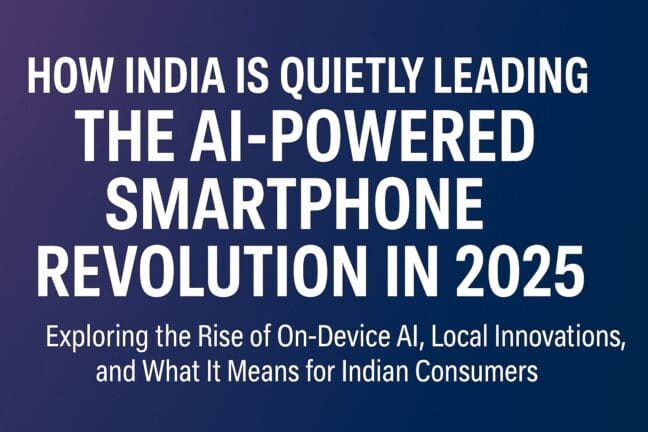
Table of Contents
Introduction: A New Era of Smartphone Revolution
In 2025, smartphones aren’t just smart—they’re intelligent companions powered by advanced AI. From summarizing calls to suggesting outfits based on your schedule, today’s devices are capable of things we once considered science fiction.
Globally, this AI wave is gaining momentum. But what’s less discussed is India’s strategic and quiet dominance in the space. With a mix of tech-savvy users, local innovation, and government support, India is not just a consumer—it’s becoming a creator in the AI smartphone revolution.
India’s Rising Role in the Global AI Smartphone Race
1. Homegrown Innovation
Brands like Lava, Micromax, and Jio are embracing on-device AI, offering features like real-time voice translation, predictive typing in Indian languages, and even AI chatbots tailored for farmers and students.
2. AI-Centric Startups
India is witnessing a surge of AI-focused mobile startups such as:
Observe.ai – Voice analysis for mobile apps
Skit.ai – AI-powered customer engagement on phones
Bhanzu AI – Learning-based AI for kids
These companies are increasingly integrating with or powering smartphone experiences.
3. Government Push
Initiatives like Digital India 2.0, Bhashini for multilingual AI, and Make in India have encouraged localization and manufacturing of AI chips and components within the country.
Top AI Features Redefining Smartphones in 2025
Today’s AI smartphones aren’t just about camera enhancements. They’re offering life-enhancing tools. Here are the leading features users are experiencing:
1. On-Device AI Search
Search across apps, files, and images offline, powered by local AI processing.
2. Smart Photography
AI-driven camera features like:
Scene recognition (Indian festivals, food, landscapes)
Skin tone customization for diverse Indian complexions
Instant background change using generative AI
3. Personal AI Assistant
Think ChatGPT-like capabilities, but offline and tailored to your usage habits. Brands like Samsung and Motorola now embed personal assistant models that adapt to your calendar, tone, and patterns.
4. Call Summarization & Real-Time Transcription
Never miss a detail—AI summarizes your business calls or interviews in real-time and supports regional Indian accents.
5. AI Battery Optimization
Phones learn your usage patterns and adjust CPU, brightness, and app sync cycles to stretch battery life intelligently.
6. AI Security
Facial recognition, fraud call alerts, spam detection, and even AI-analyzed app behavior to detect suspicious activity.
Indian Brands vs Global Giants: Who’s Ahead?
| Feature | Global Brands (Samsung, Apple) | Indian Brands (Lava, Micromax, Jio) |
|---|---|---|
| On-device AI | Advanced, multi-language | Strong in regional languages |
| AI Assistant | Proprietary & powerful | Voice-AI optimized for India |
| Pricing | ₹50,000+ | ₹10,000–₹25,000 |
| Chipsets | Custom AI accelerators | Mediatek & Snapdragon with AI cores |
| Government support | Limited | Backed by Digital India & PLI schemes |
Takeaway: Indian brands may lack hardware muscle but lead in local relevance, language support, and affordability.
How AI Phones Are Changing Lives in India
For Students:
Personalized study planners
Voice-to-text tools for notes
Doubt-solving AI in Indian languages
For Professionals:
Email & meeting summary generators
AI note transcription apps
Real-time translation for business calls
For Farmers & Rural Users:
AI chatbots in Hindi & regional dialects
Market price updates and agri-tips via voice
Image-based crop diagnosis using AI vision
For Elderly & Disabled Users:
Voice-based phone operation
Health alerts and medicine reminders
Emergency help via gesture AI
India’s AI revolution is inclusive, reaching deep into tier-2, tier-3 cities, and even rural belts.
Challenges India Faces in Scaling the AI Revolution
1. Data Privacy Concerns
On-device AI mitigates some risks, but unclear data policies and limited user awareness can be dangerous.
2. Low-End Hardware Limitations
Budget phones often lack the processing power for sophisticated AI tasks, affecting user experience.
3. Internet Dependency
Although AI is moving on-device, many features still require cloud access—which remains inconsistent in remote areas.
4. Language & Accent Diversity
Despite strides, AI still struggles with dialect-specific accents in states like Assam, Odisha, and North-East India.
The Road Ahead: What the Future Holds
AI Chip Manufacturing in India: TATA and Reliance are investing in local AI chip fabs.
5G + AI = Real-time Intelligence: Instant language translation, gaming optimization, and real-time video editing will go mainstream.
AI in Wearables: Smart rings and watches will get AI features that sync with phones for enhanced health and productivity.
India has the talent, consumer base, and innovation capacity to not only adopt but define the next generation of intelligent mobile experiences.
Conclusion
While the global spotlight often remains on Apple, Google, or Samsung, India is quietly building an AI-first mobile future from the grassroots up. From regional language support to inclusive AI for the differently-abled, Indian smartphones are shaping a smarter, more accessible world.
2025 may be the year we stop calling them just smartphones—and start calling them smart companions. And India will be at the heart of it.
FAQs
What is an AI-powered smartphone?
An AI-powered smartphone uses artificial intelligence to improve functions like photography, voice commands, battery use, and predictive actions—often without requiring internet access.
Which Indian brands are making AI phones?
Brands like Lava, Micromax, and Jio are creating budget-friendly smartphones with AI features localized for Indian users.
Can AI smartphones work without internet?
Yes. Many 2025 phones use on-device AI, allowing them to perform tasks offline like voice typing, smart replies, or battery management.
Are AI phones safe for personal data?
Mostly yes, especially if on-device AI is used. However, users should review data permissions and avoid unknown apps to stay secure.
Will AI phones replace personal assistants?
Not entirely, but they’ll become your first layer of smart support, handling daily productivity, scheduling, and even emotional well-being tasks.
